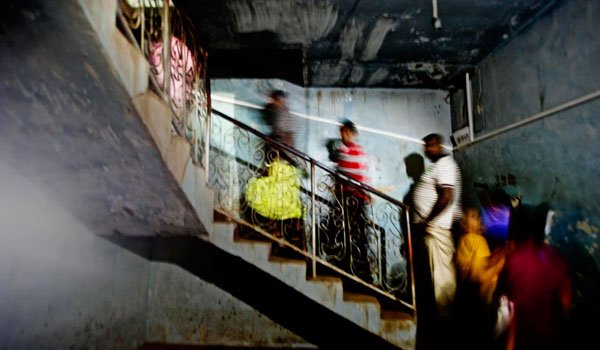###
This week, there is a major international conference on tourism, in Pasikudah, in the Batticaloa district, Eastern province of Sri Lanka. The theme is “Tourism: a Catalyst for Development, Peace and Reconciliation”. It’s organized by the UN’s World Tourism Organization (UNWTO), “the UN agency responsible for the promotion of responsible, sustainable and universally accessible tourism”, along with the Sri Lanka Tourism Development Authority (SLTDA) and the Ministry of Tourism Development and Christian Religious Affairs. The Sri Lankan President is due to attend.
Local community’s involvement in the conference
Pasikudah is a fishing village. It’s an area severely affected by the war and tsunami, with many having been killed, disappeared, injured, tortured, detained, displaced and with large number of war widows and women headed households. It had also been a popular beach for local and foreign tourists. Before the advent of large hotels owned and staffed primarily by outsiders, many local people had tried to develop their economy through small scale guest houses.
When we met fisherfolk and local guest house owners and staff last month, they didn’t know about this event, had not been consulted or invited. Organizers have opted to recommend high-end hotels owned and managed by outsiders for conference participants to stay, instead of local guest houses. Local civil society groups that we met in Batticaloa, the district capital and the closest major city to Pasikudah also didn’t know about the conference.
Those seriously affected by the three decade old war have been totally left out at a conference claiming to discuss peace, reconciliation and development. There doesn’t appear to be any opportunity for participants to listen to them and how they may view tourism and their expectations. There is also no space or focus in the agenda on gender issues.
Misleading participants
The material provided for participants by organizers, is misleading as it withholds key information about the context and background of peace and development in Sri Lanka and Pasikudah. Language has been a key issue that led to war and the organizers are incorrectly portraying that the language of the majority, Sinhalese, as the official language, at a conference held in a pre-dominantly Tamil area ravaged by the war. Numerous reports by local and international groups and the UN about the human rights situation in the past and present finds no reference in extensive pre-conference materials featuring images of sunny beaches.
Proposed pre & post conference destinations include Kandy and Nuwara Eliya, districts which grow much of Sri Lanka’s famous tea. The visit itinerary includes visits to tea factories and plantations. But it doesn’t include a visit to “line rooms”, the cramped and basic shelters where workers live. The visitors are not likely to be given opportunities to learn about the historical and ongoing socio-economic-political marginalization of tea workers, many of whom are women, on whose sweat and blood the tea industry is built on, with very little benefits to themselves.
Some major concerns about tourism and local communities
In major tourism development areas such as Pasikudah, Kalpitiya (Puttlam district, North Western Province) and Kuchaveli (Trincomalee district, Eastern Province), local communities have not been consulted and inadequate information had been provided to them about large scale tourism projects that affects their lives. Some had learnt of proposed tourist projects through prohibition notices restricting their freedom of movement. Sinhalese, Tamil and Muslim communities, men, women and children, have all been negatively affected.
Historical landscapes have been changed and mangroves destroyed due to large scale tourism projects in different parts of the country. Environmentalists had reported that the Colombo “Port City” project, which aims at high end tourists, will cause serious damage to the environment. In Kuchaveli, community playgrounds, community centres, wells close to the sea and a Hindu temple had been occupied due to tourism projects. In Kalpitiya, access to a Catholic Church had been blocked and, local communities have complained about water shortages for drinking and everyday use, due to high water consumption in hotels.
Tourism initiatives, by the military and private companies, had resulted in local populations losing their traditional lands, seriously affecting community life and cultures. Individuals and whole communities in Kuchaveli, Kalpitiya, Jaffna (Northern Province) and Panama (Ampara district, Eastern Province) have lost their traditional lands and villages due to tourism projects.
Fisherfolk in Pasikudah told us that their fisheries centres and moorings have been displaced multiple times due to building up of large hotels. The hotel hosting the conference, Amaya Beach Resort, is situated where their fisheries centre was located. The Pasikudah fisherfolk have been compelled to walk several kilometers to the present day mooring. Over 300 fisherfolk have to share a very small 300m section of the 5km long beach. In Kuchaveli nine access points to the sea has been blocked and fisherfolk have to walk about 3km to the sea. Most permanent employees in hotels appear to come from outside. Fisherfolk in Pasikudah also told us that large hotels in Pasikudah don’t purchase fish from them, but do their purchases through intermediaries. There are also questions about adequate compensation, social benefits and rights to unionize of workers employed in major hotels.
Militarization of tourism
There is a strong military presence and involvement in Northern Sri Lanka and this also extends to tourism. It’s a military which stands accused of serious and systemic human rights violations, by the local population, domestic and international human rights groups and the UN. Despite some releases in last 18 months, it continues to illegally occupy large swathes of lands belonging to Tamils. Some lands of Muslim and Sinhalese are also occupied by the military.
The military runs farms, pre-schools, shops, tourist centres, tourist resorts, restaurants, boat tours and airlines. According to organizers, conference participants will also travel by a “passenger vessel of the Navy”. In Panama and Jaffna peninsula, people were deceived into believing the Navy and Army had occupied their lands to build military bases, but subsequently discovered that these lands were used to build military run resorts.
The military has also built many monuments glorifying itself, despite many local Tamils considering them as being responsible for mass atrocities in the past. The military had bulldozed cemeteries and destroyed memorials of Tamil militants. Efforts of civilians to remember those killed and disappeared, led by Tamil political and religious leaders had been met with threats, intimidations, restrictions, surveillance and court orders banning them. Despite some improvements in last 18 months, there is no positive environment for civilian initiatives for monuments and remembrance events. Government initiatives for remembrance remains focused also on the military.
Tourism and international experiences of memorialization
Across the world, monuments of past tragedies had become major tourist attractions. Holocaust memorial in Auschwitz and across the world, Constitutional Hill (former prison) and Apartheid Museum in South Africa, Tuol Sleng Genocide museum in Cambodia and the memorial at the massacre site in Gwanju, South Korea are just very few examples. They play a very important role in retaining memory, educating visitors (domestic and international) and conveying stories of experiences of survivors and victims of human rights violations and war.
One of the most striking of such memorials is in Derry, in Northern Ireland, which was badly affected by the “troubles”. A walking tour of “Derry Bogside” retraces parts of the original march and visits places where the dead and wounded fell on “Bloody Sunday”, examining its’s political and social repercussions and offering onsite experience and insights. It’s curated by the son of one of the victims and offers a unique perspective to tourists. The Museum of Free Derry tries to tell the city’s history from the point of view of the people who lived through, and were most affected, instead of “distorted version parroted by the government and most of the media”, as a step towards understanding of elements that led to the conflict.
Tourism in Sri Lanka is far from such initiatives. Less than an hour away from Pasikudah, Satharakondan and Kathankudi, there are monuments to remember massacres by the government forces and LTTE, which local Tamil and Muslim communities have built and maintain. No visits to such sites are planned in this conference to discuss “peace and reconciliation tourism”, to learn from war-affected people and express solidarity and offer encouragement and support. Instead, organizers are offering “technical tours” of several hours, to war affected Trincomalee and Jaffna. The itineraries indicate that the aim is to highlight the beauty of the place and sweep under the carpet serious human rights violations and social, economic issues affecting local people, such as unemployment, caste and gender based discrimination and violence.
Towards a more meaningful tourism
Tourism must be centered on local populations and war affected peoples. Consultations with them is crucial if tourism is to act as catalyst for peace, reconciliation and development. Tourism projects should take into account their sufferings, aspirations and support their struggles for truth, justice and economic development in a sensitive way.
Tourism must not destroy or damage socio-economic-cultural practices of local communities and uproot them from their traditional lands and livelihoods. They should not be marginalized and denied economic opportunities presented. Environmental protection is linked to community life and livelihoods and thus this is a crucial factor in any tourist projects.
Only very few individuals have obtained redress for lands they lost due to tourism projects, by going to courts. It would be important to have accessible, effective and independent grievances mechanisms, which could prevent abuses in context of tourism projects by the state or private companies, or provide redress to victims.
Government and military must not use tourism as means to promote their political agendas and propaganda. Memorials and other remembrance initiatives by local communities must be promoted and government must also initiate official monuments and remembrances focusing on civilians and all those affected.
Post-war tourism in Sri Lanka has been dominated by large scale hotel chains, investors and a powerful military machine. It’s driven by neo-liberal, capitalist economic and development policies and majoritarian Sinhalese – Buddhist ideology. It has exploited and left behind local populations in tourist sites and war affected survivors and victim’s families, in dark shadows of dispossession, displacement and marginalization. Will this conference rubber stamp and encourage this stampeding tourism train running over all before it, or will it genuinely attempt to promote peace, reconciliation and development in Sri Lanka through tourism?
Sources:
Visits and meetings with local communities by authors and colleagues
Authors visits to sites of “peace tourism” overseas
“Dark Clouds over the Sunshine Paradise – Human Rights & Tourism in Sri Lanka”, Society for Threatened Peoples
(Ruki Fernando and Herman Kumara - groundviews.org)






